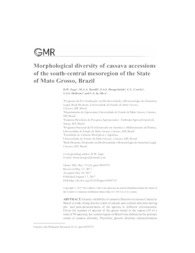Morphological diversity of cassava accessions of the south-central mesoregion of the State of Mato Grosso, Brazil.
Morphological diversity of cassava accessions of the south-central mesoregion of the State of Mato Grosso, Brazil.
Author(s): ZAGO, B. W.; BARELLI, M. A. A.; HOOGERHEIDE, E. S. S.; CORRÊA, C. L.; DELFORNO, G. I. S.; SILVA, C. J. da
Summary: Genetic variability of cassava (Manihot esculenta Crantz) in Brazil is wide, being this the result of natural and cultural selection during pre- and post-domestication of the species in different environments. Given the number of species of the genus found in the region (38 of a total of 98 species), the central region of Brazil was defined as the primary center of cassava diversity. Therefore, genetic diversity characterization of cassava accessions is fundamental, both for farmers and for plant breeders, because it allows the organization of genetic resources and better utilization of available genetic diversity. This research aims to assess genetic divergence of cassava accessions from the south-central region of the State of Mato Grosso, based on multi-categorical morphological traits. For this purpose, 38 qualitative and quantitative morphological descriptors were used. Genetic diversity was expressed by the genetic similarity index, with subsequent clustering of accessions by the modified Tocher?s procedure and UPGMA. Of 38 descriptors, only growth habit of stem showed no variability. Tocher and UPGMA methods were efficient and corroborated on group composition. Both methods were able to group accessions of different localities in distinct group consistency.
Publication year: 2017
Types of publication: Journal article
Keywords: Genetic variation, Manihot Esculenta, Multivariate analysis
Observation
Some of Embrapa's publications are published as ePub files. To read them, use or download one of the following free software options to your computer or mobile device. Android: Google Play Books; IOS: iBooks; Windows and Linux: Calibre.
Access other publications
Access the Agricultural Research Database (BDPA) to consult Embrapa's full library collection and records.
Visit Embrapa Bookstore to purchase books and other publications sold by Embrapa.

